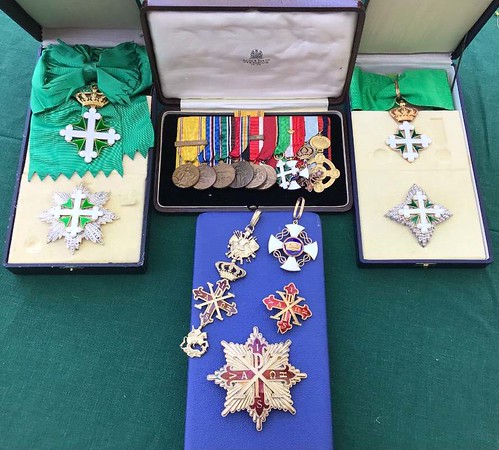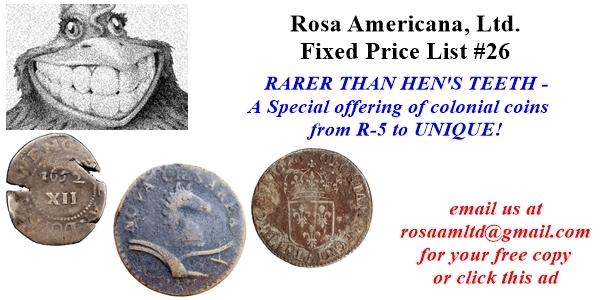
PREV ARTICLE
NEXT ARTICLE
FULL ISSUE
PREV FULL ISSUE
JAMES CHARLES RISK (1913-2005)E-Sylum Feature Writer and American Numismatic Biographies author Pete Smith submitted this article on long-time Stack's staffer Jim Risk. Thanks! -Editor James C. Risk was an authority on orders and decorations. He was a long-time manager and cataloguer for Stack's Coin Galleries and editor of their Numismatic Review.
James Charles Risk (1913-2005)
Risk graduated cum laude from Dartmouth in 1936. He went to graduate school at Harvard before becoming a teacher at MIT. War interrupted his career and he joined the Navy in 1940 as an ensign. He served as a lieutenant on escort ships Dahlgren and Jeffers crossing the Atlantic. He was there at Sicily for that invasion. He wrote Administrative History of the US Navy in the Mediterranean which led to an appointment to the Allied Commission on the Democratization Of Italy. While in the diplomatic service, he became friends with Pope Pius XII, King Umberto and the Duke of Wellington. Risk joined the American Numismatic Society on June 1, 1939, and was a member and Life Fellow for 66 years. After the war, the American Numismatic Society published his British Orders and Decorations in 1945. Risk had studied orders and decorations. Following the war, Queen Elizabeth asked him to catalog and organize England's Royal orders and decorations. Many had been hidden in various locations during the war. He cleaned and repaired items in the collection and replaced missing ribbons. Queen Elizabeth was impressed with his efforts and honored him with the Royal Victorian Order. He was the first American to receive that honor. Risk himself received a few decorations. King Umberto granted him the title of Knight of the Order of Saints Maurice and Lazarus and Commander of the Order of the Crown of Italy. Later he was created a Knight of Grace of the Sacred Military Constantinian Order of St. George and Commander of the Order of Malta With Swords. Risk left the Navy with the rank of Lieutenant Commander. He joined the Ministry of Foreign Affairs with postings to Vladivostok and Saigon. He left foreign service to take a job with Coin Galleries in New York, His application for membership in the ANA was published in September 1952. He was assigned number 20277. His address was c/o The American Numismatic Society in New York. Coin Galleries was the world coin division of Stack's. As manager, Risk frequently travelled to Europe on business and was known to the major European dealers. Back in America, he was a frequent lecturer and award-winning exhibitor. The full name of the periodical was The Numismatic Review and Coin Galleries Fixed Price List. It was a marketing tool for the company and much more. The articles were scholarly and informative. Risk's editorials were not the all too familiar promotional hype. They offered commentary on the hobby and on the market. Risk attempted to call attention to the lack of education of some collectors and flaws in other publications.
The November 1962 issue of The Numismatist included an article,
The ANA presentation revealed the existence of the
Spink had acquired the
As editor for Numismatic Review, he signed his name as
One editorial stated,
For the first issue of Numismatic Review in 1970, James C. Risk published
James C. Risk died in New York City on October 24, 2005. He had been a Fellow of the Society of Antiquarians of London (FSA), a Knight of Justice of the Order of the Hospital of Saint John of Jerusalem. He belonged to the Naval and Military Club, the Royal Overseas League, and The Harvard Club in New York City. He had served as Chairman of the American Foundation of Savoy Orders and served on the executive committee of the Saint George Society of New York. This picture shows Orders awarded to James C. Risk. The ones with the green ribbons relate to the Order of Saints Maurice and Lazares. The ones on the blue pad are related to the Sacred Military Constantinian Order of Saint George. Who is the expert who can identify the rest? Great question - can anyone help? -Editor
To read the earlier E-Sylum articles, see:
Wayne Homren, Editor The Numismatic Bibliomania Society is a non-profit organization promoting numismatic literature. See our web site at coinbooks.org. To submit items for publication in The E-Sylum, write to the Editor at this address: whomren@gmail.com To subscribe go to: https://my.binhost.com/lists/listinfo/esylum All Rights Reserved. NBS Home Page Contact the NBS webmaster 
|



